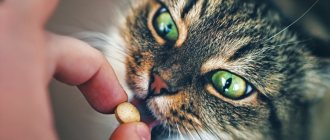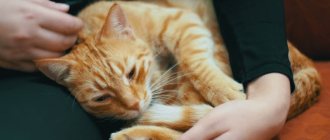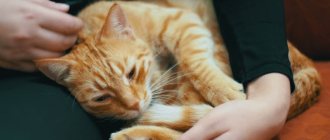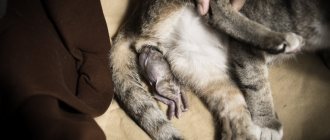Childbirth in a cat. How can I help her and what should I do?
In the wild, cats are independent and can get by without human help. But if this is the first birth of a cat, especially a domestic cat, then often at that moment they do not understand what is happening to them. The natural instinct is so small that the owner’s help is needed not so much by the mother herself as by the newborn kitten. After all, it often happens that a mother cat, having barely given birth, leaves the nest out of fright, leaving an untreated baby. Therefore, our task is to know how to deliver a cat, help her, calm her down, and, if necessary, treat the kittens instead of her.
A cat's pregnancy lasts on average 65 days. On the eve of giving birth, the cat's stomach drops, the mammary glands swell and the so-called plug (yellow-brown mucus) comes out. A day or two before hour X, rectal body temperature drops from 38.6 to 37 degrees, but then returns to normal.
Don’t be nervous or worry too much, because your pet senses the mood of your loved one. When pregnancy and childbirth proceed without pathologies, everything happens by itself, without the intervention of the owner. If something goes wrong, only one thing is required - call the veterinarian in time.
At home or in the clinic?
If the pregnancy proceeds without serious complications, giving birth at home is the best option. The cat should give birth in a calm environment where she feels safe.
In case of pregnancy pathologies, childbirth at home is also possible - you just need to agree with a veterinarian, who will examine your pet in advance and will be well aware of its problems. An obstetrician must know how to deliver a child in the presence of a specific pathology; he must be a competent specialist, and not an ordinary therapist. A hospital birth is preferable if there is a serious problem that requires medical support throughout the process (for example, the cat has heart failure or a respiratory disease).
Normal and abnormal course of labor
Prevention of all possible complications during childbirth begins with caring for a pregnant cat . As soon as you discover that your pet is pregnant, regardless of whether mating was planned, she must be shown to a veterinarian.
A cat's pregnancy can be determined from 2–3 weeks using a blood test. At 3–4 weeks, the expectant mother's mammary glands swell. As the gestation period increases, the following signs are observed:
- Increased hunger.
- Redness of the nipples.
- Toxicosis.
- Slight but constant weight gain.
- Behavioral changes - frequent meowing, restlessness, unusual affection or irritability.
During the normal course of pregnancy, by about 5–6 weeks, the pet’s belly becomes noticeably rounded. If gestation proceeds without complications, the cat receives decent care, has no genetic defects, and birth occurs from 64 to 71 days of pregnancy.
Important! During the normal course of pregnancy, before the onset of contractions, the cat should not experience any discharge from the genitals. The only exception is early rejection of the mucus plug, which can occur several weeks before birth.
It will be easier for an inexperienced owner to cope with the situation if the nest for birth is prepared in advance. It is necessary to monitor the cat’s behavior; most often, she herself chooses a suitable (from her point of view) place. You can take the initiative and equip a nest for your cat from a spacious box. In order for the expectant mother to feel safe, the box must be closed (have a roof).
During the first contractions, you may find that the cat is restless, constantly entering the nest, or looking for a suitable place to give birth to kittens. The pet can meow loudly and attract the attention of the owner, especially if she is about to give birth for the first time. The first contractions bring discomfort, but the cat successfully hides the pain. The owner may not notice the discharge of amniotic fluid and the rejection of the mucous plug, since the cat licks the genital area.
As the labor process progresses, contractions will intensify and the interval between them will decrease. When the interval is reduced to 20–30 seconds, the cat will lie down on its side and prepare to push.
The first kitten takes longer to be born than all the others; to expel it, the cat will need to make 3-4 strong attempts. The total duration of the process from the start of contractions to the appearance of the first kitten can take from 2 to 24 hours. Normally, contractions last up to 12 hours, and pushing at the birth of the first kitten lasts up to 1 hour.
Note! After the birth of the first kitten, the remaining babies should appear at intervals of 10–20 minutes.
As soon as the baby is born, the cat licks its face, gnaws the umbilical cord and eats the afterbirth. If the woman in labor does not pay attention to the kitten, and the expulsion occurs too quickly, the pet may be in rapid labor. This complication is associated with severe pain, so it is advisable to immediately remove the kittens from the nest, remove fluid from the respiratory tract, rub them and place them on a heating pad.
Stimulation of labor.
It happens that all the deadlines have already passed, and the pet is not going to give birth. Owners begin to think about how to induce labor. Sometimes this is really necessary: the kittens grow, exhausting the mother and increasing in size, which can complicate the birth process. However, under no circumstances should you take any action on your own, without the advice of a veterinarian! Stimulation with “folk” remedies can prolong the cat’s labor time (prolonged labor, weak pushing, etc.). Injecting oxytocin or an analogue into a cat that is not physically ready to give birth will cause cervical rupture. Only the doctor decides in each specific case how to induce labor and whether it is necessary at all. If it’s really time, the doctor will give the pet an injection of a hormonal drug, which will trigger the normal onset of labor.
How to act
If there is a need to induce contractions in a cat, you need to use Oxytocin. This drug will help strengthen the tone of the muscle tissue of the uterus before labor begins. The medicine is administered intramuscularly or subcutaneously; its effect begins within 2-3 minutes after the injection. It is very important to follow the dosage, otherwise complications may arise, including the death of the kittens.
How much drug should I use? For cats, the following dosage should be used: 0.2-0.3 ml for intramuscular or subcutaneous injection, the injection is given between two contractions. If there is no result within 1/3 hour, the drug is re-administered at the same dose. The maximum number of injections is 3; if there is no effect, you cannot increase the dosage - this will lead to negative consequences.
How to give an injection? To help your pet give birth to offspring, you should inject the drug into the withers. To do this, the animal’s skin is grabbed with one hand and an injection is made into the hollow formed at the back. It is important to puncture the skin and inject the drug between the skin and muscles.
© shutterstock
The intramuscular injection is easy. The optimal place for the injection is the thigh, the paw is held with one hand, and the syringe needle is inserted at an angle with the other hand. After the procedure, the injection site should be gently massaged, this will help the drug dissolve faster. Similar injections are given if the cat carries the pregnancy to term.
It is extremely important to wash your hands thoroughly before injection and use only sterile instruments. The same needle cannot be used twice.
How long does a cat's pregnancy last and when is it due?
On average, pregnancy lasts about three months, from 60 to 63 days.
But there are some nuances:
- yard cats generally give birth on the 50th day of gestation;
- Siamese cat breed, usually gives birth between 70 and 75 days ;
- cats with a small body composition, such as British and Scottish breeds, give birth in 60 - 65 days , and those who are obese often overweight;
- in young individuals before the first year of life, premature births often occur and the offspring often die.
The maximum permissible duration is 71 days. Minimum from 56 to 60 days.
Oxytocin for dogs
The article focuses on one of the most popular drugs in veterinary practice, which can cope with certain problems. This article is presented for informational purposes only, since the decision on its use can only be made by a veterinarian after examining a four-legged patient.
Oxytocin for animals is used when it is necessary to increase the contractility of the uterus and glands that produce milk.
The drug is administered mainly subcutaneously, less often intravenously. The dose of medication recommended in the instructions for dogs of medium breeds is from 5 to 10 ml. To dilute the drug, saline is used. solution. It is better to pre-coordinate the injection schedule with your veterinarian. If this is not possible, then you can try the option of 5 injections every 40 minutes.
Oxytocin in tablets is not as effective as that used in injections.
Oxytocin for dogs can be ordered online or by visiting your regular veterinary pharmacy. Reviews about this medicine are very positive - it is an effective and inexpensive drug.
The cost of a 20 ml bottle is 25 UAH.
Whether or not to give oxytocin injections to a dog with endometritis or pyometra should be decided by the veterinarian on a case-by-case basis.
For example, with pyometra, if the cervix is closed, an injection of oxytocin can provoke uterine rupture and, in turn, cause the pus accumulated in the uterus to spread throughout the animal’s abdominal cavity, so it is better not to self-medicate.
Oxytocin is most often used to contract the uterus in animals. Its analogues are hyfotocin, mammophysin and pituitron, however, the use of these drugs during childbirth is not recommended, as they can disrupt placental circulation and cause the death of puppies.
The release form of oxytocin and its analogues is an injection solution.
{amp}gt;Use of the drug oxytocin for animals. "Oxytocin" to intensify contractions and after childbirth: dose, technology of application.
Stages of bearing a kitten
Veterinarians divide the period into:
- Fertilization period;
- Embryonic;
- Fetal.
| A week | Development |
| First | The zygote is fragmented, and molures are formed - a mass of blastomeres that are located in a transparent shell. |
| Second | Molurs descend into the uterine cavity. Division continues, and blastocysts appear, which disperse along the horns of the uterus. |
| Third | The blastocysts hatch and the pregnancy enters the embryonic stage. |
| Fourth, fifth | The membranes are laid, the baby's tissue and placenta are formed. |
| Sixth, seventh, eighth | The final period: the fruits develop, gain weight, and organs form. |
| Ninth | Childbirth |
How to help pets after giving birth?
After giving birth, a cat should be given Oxytocin if contractions were uneven. This means that the contractions are weak and artificial stimulation is required to restore the animal.
Traumwell can be given to weakened kittens. This is an anesthetic drug: dripped into the mouth every 20 minutes for 2 hours.
You can give your cat Oxytocin during birth, but you shouldn’t give it afterwards if there was heavy blood loss during the birth of the kittens. Excessive stimulation can cause uterine wall rupture. If there are no complications, Oxytocin is administered within 3 hours after the kittens are born, and a dosage of 0.25 ml every 30 minutes is repeated every other day.
You can have exotic animals in your home and show off your unique menagerie to those around you. Or you can bring a defenseless mongrel pet, picking it up on the street, and life will become warmer. Some people prefer a mixed version - an ordinary cat, but a purebred one, bred through selective breeding.
Pets do not share the lives of their owners in everything; they also have their own “interests”. The most basic of them is procreation. A person’s friends, chosen at the behest of the heart, in most cases cope with this process on their own.
Pedigree animals, cats or dogs, may need help. If a veterinarian is not present at the birth, the owners will have to provide obstetric care.
The most commonly used medication during childbirth is Oxytocin.
How to recognize pregnancy at the initial stage
It is quite difficult to recognize whether a pet is pregnant at the initial stage by behavioral and physiological changes. Starting from the third week, a cat may vomit due to changes in the body. The mammary glands swell and become more scarlet.
The animal sleeps more than usual and becomes more affectionate. Behavior changes due to hormonal changes.
The pet eats a lot due to the increased needs of the body.
The belly becomes rounder towards the fifth week.
The surest way to confirm a probable pregnancy is best with an ultrasound examination. Recommended duration: from 20 days from mating.
helping a cat give birth
A cat's gestation period is 58-72 days. If the cat’s labor is good, then there is no need to use medications before and during birth. After birth, two hours after the last kitten, oxytocin can be administered to better cleanse the uterus and increase milk lactation. use of medications during cat birthFor experienced breeders this advice is unnecessary, but for beginners I would like to remind you that you are not a veterinarian. Therefore, use medications very carefully and do not try to pour and inject everything into the cat. Improper use of medications can seriously harm your cat.
traumatizing a cat during childbirth
Travmatin® acts on the neuroendocrine system, stimulates the production of endogenous (own) oxytocin, which leads to uterine contractions. In addition, Travmatin® has an analgesic and hemostatic effect. Even during normal childbirth without obstetric care, there is a risk of microtrauma to the mucous membrane of the cervix and vagina. Therefore, Travmatin® should be administered both at the beginning of labor and at the end of the process. This allows you to avoid complications both during childbirth and in the postpartum period, prevents inflammatory diseases of the genital organs and promotes normal involution of the uterus (when the uterus returns to its original state). The composition of Travmatin® in microdoses includes natural components created on the basis of plant raw materials, so it is absolutely harmless to the fetus and the mother in labor.
Dosage of the drug for cats
- 1 ml. Travmatin® is injected subcutaneously into the withers area or intramuscularly. In addition, the drug can be given orally in 5-15 drops (if it is impossible to give an injection, a very small or nervous animal), if necessary (weakening of labor in case of large fetuses or large litter size), frequent administration is possible (every 15-20 minutes).
If the postpartum period is accompanied by severe bleeding from the genitals, the animal must be given an injection of Travmatin® and consult a doctor immediately!
Don’t panic, stay calm, keep Travmatin® on hand, and your animal will give birth naturally and easily.
Gamavit for a cat during childbirth
Subcutaneously, 2 ml before birth or during childbirth as needed. Gamavit is used to normalize labor in complicated cases. The drug stimulates the smooth muscles of the uterus, accelerating and facilitating the birth process, and promotes rapid cleansing of the uterine horns from dead fetuses.
For weakened kittens, 0.01 ml subcutaneously.
oxytocin in a cat during childbirth
Oxytocin has the ability to enhance contractions of the smooth muscle of the uterus and myoepithelium of the mammary gland.
Attention!
Oxytocin can be released in different forms. Oxytocin 5 units and oxytocin 10 units. Recalculate the dosage in accordance with the purchased drug!
This drug is injected during weak labor. It causes contractions of the uterus. In most cases, oxytocin is not recommended until the first kitten is born. It is also strictly contraindicated in the case when the kitten is stuck in the birth canal.
Oxytocin is injected into the withers in a volume of 0.2-0.3 ml. One time. NOT INTO A FIGHT! If after 20 minutes there is no reaction, then inject again. In case of weak labor, they usually inject according to this scheme - 02. ml 3 times with a break of 20 minutes. You can inject intramuscularly, then the reaction will follow faster.
!!!
Oxytocin is contraindicated during obstetrics in cases of a large fetus, its deformity, as well as in case of incorrect position and position. a cocktail that stimulates labor in a cat.
If you are afraid to administer oxytocin, administer a 10 ml s.c. cocktail. No risk at all, just pure benefit. Tested in prolonged labor.
The action of the cocktail is fundamentally different from the mechanism of action of oxytocin and similar drugs (oxytocin “works” at the level of nerve fibers, “forcing” the muscles of the uterus to contract, and the cocktail stimulates the contraction of the smallest blood vessels without affecting the nerves... therefore “uterine fatigue” does not coming...
Moreover, if it is necessary to use oxytocin, “before that” it is recommended to inject such a cocktail...
In addition, the cocktail DOES NOT ALLOW uterine ruptures and bleeding, and the largest kittens are born remarkably and without problems only with its use (without the participation of oxytocin)...
You can prick UNTIL INFINITY - as much as needed = uterine fatigue DOES NOT OCCUR.
The difference between subcutaneous, intramuscular and intravenous administration is the speed of action... Roughly speaking, the result occurs subcutaneously in 10 minutes, intramuscularly in 5 minutes, intravenously - instantly.
After the birth of Supposedly the last kitten, I always inject oxytocin.
Cocktail - I inject for another 3 days, after giving birth (1 injection per day, in the same dosage as during childbirth) ... and again - reinsurance, for possible eclampsia ... NOW THE RECIPE ITSELF: 4
ml (cube) glucose 4 ml (cube) calcium gluconate 2 ml (cube) ascorbic acid Take all components into one syringe, total volume = 10 ml (cube). Inject at the rate of 2 cubes per 10 kg of cat’s weight. Single dose for a medium-sized cat = 1 ml.
Injection after the birth of the first kitten!!!
Maintains the tone of the uterus and stimulates the release of clots, replenishes fluid loss and feeds, “washes out” the placenta, stimulates milk production.
Very good during long labor. cocktail to restore strength and energy
calcium gluconate 10% -2 ml ascorbic acid - 1 ml glucose 5% - 7-10 ml For two subcutaneous injections of 10 ml every hour. The cat's weight is from 3.5 to 5 kg. Do you understand? not for stimulation, not for vitaminization, and not for prevention - To replenish what was lost!!!
This cocktail is used ONLY DURING childbirth (after 3-4 kittens) or AFTER BIRTH.
To replenish lost: strength and energy (nutrition and fluids - glucose, stress relief and removal of toxins - vitamin C, calcium.) Calcium gluconate during childbirth in a cat
Calcium gluconate or calcium borgluconate (1 ml intramuscularly)
Calcium gluconate is injected only INTRAMUSCULARLY (!!!), warmed up to body temperature (the required amount is drawn into a syringe and held in the hand until it warms up).
The drug gently enhances contractions and labor, and also promotes milk production. During childbirth, calcium is injected when regular contractions begin (see the cat's condition, if necessary). 1 ml at a time, bring to 4 ml.
After childbirth, a prophylactic dose of 1 ml once a week. If the cat shows the first signs of eclampsia, give it 1 ml in the morning and 1 ml in the evening for three days.
To relieve an attack of eclampsia, inject 2 ml, repeat after 30 minutes until the attack is completely relieved. The maximum total dose is 10 ml. You can drink calcium gluconate, but it’s useless!
In addition, it is advisable to give the cat a sedative; with the sedative, the signs of the disease go away much faster.
The veterinary drug calcium borgluconate is injected INSTEAD of calcium gluconate according to the same scheme, subcutaneously or intramuscularly. Don't solder!!!
Traumeel (traumatin) one drop in the mouth of a weakened kitten every 15 minutes for two hours.
For cats, 0.5–2 ml subcutaneously or intramuscularly to relieve pain. helping a cat during childbirth if the kitten is stuck at the exit
During the normal course of labor, you should not interfere with this natural process, you can simply help the female.
If the cat has pinched the kitten out of pain and fear, for example, in the neck area (i.e. body out, head in), then by gently pulling you can try to speed up the birth.
This is especially important in breech presentation, when compression of the umbilical cord is possible. At the same time, oxygen ceases to enter the fetal body, as a result of which a reflex inhalation follows and amniotic fluid enters the lungs. With a cephalic presentation, the membranes are open, air can pass into the lungs during breathing movements. It is better to pull the fetus by the folds of skin on the neck or torso, always during pushing, carefully, but quite strongly, as if in an arc - outward and downward. If the birth canal is dry, it needs to be moistened. a bubble is sticking out
If it is a bubble that is sticking out, then you don’t need to do anything, just don’t let the cat bite through it.
You can begin mechanical stimulation of contractions. the cat does not bite the umbilical cord.
The kitten “hangs” on the umbilical cord.
We free the kitten's nose from the amniotic sac. Grasp the umbilical cord with your thumb and forefinger as close to the cat's vulva as possible. During the contraction we stretch. If there are no contractions, but the cat jumps up and spins around, sits down (risk of crushing the kitten), cut it off. Ideally, of course, use a medical clamp. The umbilical cord was clamped. Cut off from the kitten's side. The remainder of the umbilical cord is secured with a clamp from the outside and will not go back into the cat. We bring the kitten back to life. Then we put it to the mother, she is distracted by it (licks it), and you take the clamp in your hands and remove the afterbirth. the placenta does not come out.
If the placenta hanging from the genital slit does not separate within half an hour or interferes with the birth of the next fetus, it is carefully removed by hand.
mechanical stimulation of contractions
We fix the cat in the “pooping” position. Gently massage the abdomen using circular movements. We put on gloves, dip a finger in Vaseline oil, insert it into the vagina 1 cm and make circular movements. If a bubble sticks out, then massage it around until contractions appear.
What dangerous symptoms can a pregnant woman experience?
If the domestic cat is in good health, gestation proceeds normally. But everything is individual and any problem or pathology may arise:
- uterine inguinal hernia - the uterus with the fetus protrudes through the inguinal canal;
- possible bleeding, which can cause placental abruption;
- In recent weeks, polyhydramnios is possible . Fluid accumulates in the amniotic membranes;
- Falls or buckles may cause uterine torsion ;
- pathologies or careless sudden falls can provoke abortion.
The pet owner should definitely contact a veterinarian if he notices the following changes in a pregnant woman:
- protrusions between the last penultimate pairs of nipples;
- blood discharge from the vagina ;
- the cat behaves restlessly and anxiously ;
- lack of appetite, apathy and general weakness of the pet;
- tense abdomen , swollen and inflamed vagina.
Sometimes double fertilization occurs: the pregnant woman is again fertilized during intercourse. The outcome can be different: either one offspring will die during childbirth, or both sets of kittens will give birth and survive.
Some animals experience premature birth due to:
- there are dead fetuses or very weak kittens in the womb ;
- infectious diseases;
- abdominal trauma
- premature placental abruption ;
- stress.
If there is an elevated temperature, vaginal discharge, or contractions begin ahead of schedule, then you need to call a veterinarian. He will either relieve the tone of the uterus or give birth. Depending on the condition of the pet.
Post-term pregnancy also happens. In this case, the animal does not give birth after 70 days and continues to carry kittens further. This may be caused by intrauterine death of kittens. You need to see a doctor. There are also cases when a pet gives birth to healthy offspring only on the 70th – 75th day.
A frozen pregnancy occurs. In this case, the fruits stop developing and die. This is due to:
- hormonal pathologies;
- inflammatory processes;
- genetic diseases;
- injuries;
- stress.
A frozen cat can be identified by its belly, which stops growing; the cat’s appetite sharply decreases. It is possible to accurately identify it only with an ultrasound. If the diagnosis is confirmed, the cat is given an abortion.
Knowing how pregnancy proceeds, how long it takes, stages and development, the owner will be able to identify signs of problems in time and help the pet bear kittens.
Causes of problems
If an animal is overweight, it can cause problems during the birth of offspring.
It is not difficult for a pregnant pet to give birth at home. However, there are situations when a long period has passed since the start of contractions, but the pet does not give birth for a long time. Often, a cat cannot give birth in the following situations:
- large size kitten;
- malposition;
- traumatic injuries;
- inflammation;
- narrow pelvis;
- incomplete dilatation of the cervix;
- abnormalities in the development of the vaginal vault;
- lack of lubrication;
- advanced age;
- excessive body weight.
Weak labor
However, often a cat cannot give birth due to the influence of the factors described above. One of the most common factors is considered to be weak labor. It is usually divided into 2 types:
Weak uterine contractions are possible when the pet’s body does not produce enough oxytocin.
- Primary light tone of the uterus. It is observed due to a lack of the hormone oxytocin in the body, which is responsible for the frequency of contractions. Sometimes this condition can be caused by a lack of calcium.
- Secondary. Cessation of uterine contractions due to severe exhaustion of the female during labor.
Analogues of the drug
If the doctor deems it necessary, he can prescribe a similar drug to the animal - Oxytocin-Richter.
Pharmacy chains also offer other medications that are given to cats during childbirth. The doctor may prescribe the following pharmaceuticals:
- "Desaminooxytocin";
- "Oxytocin grindex";
- "Oxytocin-biolek";
- "Oxytocin Richter."
It is important to remember that it is strictly prohibited to independently replace a prescribed medication. All medications have their own side effects and contraindications for use, which are important to consider before using them. Only a veterinarian who is familiar with the cat’s medical history and the individual characteristics of its body has the right to replace the medicine.
special instructions
While using the medication, the cat owner is prohibited from eating, smoking and drinking. After the first injection and each subsequent time, it is important to wash your hands thoroughly with soap. The container containing the medicine must be disposed of immediately and not used for household purposes. If the medication gets on the mucous membranes or skin, you need to rinse them as soon as possible with plenty of water. When allergy symptoms appear, you should not hesitate to visit a medical facility.











